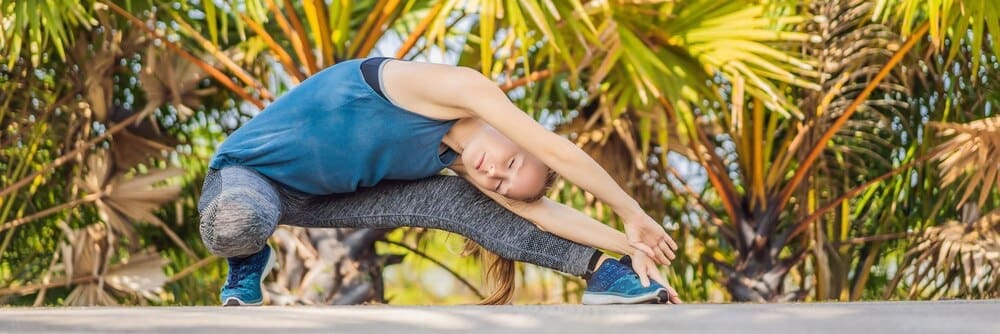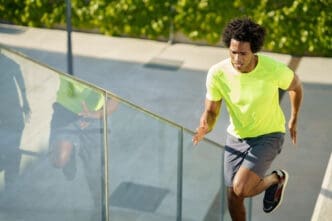For runners pounding the pavement under the South Florida sun, unlocking peak performance and preventing injury requires more than just logging miles. The key lies in a complementary practice that builds resilience, flexibility, and strength—yoga. By integrating specific yoga poses into their routines, either before a run, after a cool-down, or on a rest day, South Florida runners can directly counteract the muscular imbalances caused by repetitive, flat-terrain running. This practice not only stretches chronically tight hips and hamstrings but also builds core stability, improves breathing efficiency in the humid air, and sharpens the mental focus needed to push through challenging conditions, ultimately transforming a good runner into a great one.
Why Yoga is a Runner’s Secret Weapon
Running is a powerful cardiovascular exercise, but its repetitive, high-impact nature can lead to a predictable set of problems. The forward-moving, sagittal plane motion shortens hamstrings, tightens hip flexors, and can create significant muscular imbalances. Over time, this can lead to common running ailments like IT band syndrome, runner’s knee, and plantar fasciitis. Yoga serves as the perfect antidote, introducing movement in all planes and focusing on the very areas running neglects.
The practice cultivates proprioception, or your body’s awareness of its position in space. This heightened awareness helps you fine-tune your running form, correcting subtle inefficiencies that might otherwise lead to injury. By strengthening the small stabilizing muscles around your joints, yoga provides a stronger foundation for the powerful, primary muscles used in running, distributing the workload more evenly and reducing strain.
Beyond the physical, the mental benefits are profound. The focus on controlled breathing, or pranayama, trains your respiratory system to be more efficient, a massive advantage when the air is thick with humidity. This mindful breathing also calms the nervous system, helping you stay focused and composed during a tough race or a grueling training run.
Addressing the Unique Challenges of Running in South Florida
Running in a subtropical paradise comes with a unique set of environmental challenges that yoga is particularly well-suited to address. The relentless heat and humidity can tax the cardiovascular and respiratory systems. A consistent yoga practice that emphasizes deep, diaphragmatic breathing can increase your lung capacity and train you to maintain a calm, steady breath rate even when your body is under stress, preventing the panicked, shallow breathing that can derail a run.
Furthermore, South Florida is famously flat. While this avoids punishing hills, it also means your muscles are engaged in the exact same pattern, step after step, mile after mile. This lack of variation is a primary cause of overuse injuries. Yoga introduces multi-planar movements—twists, side bends, and backbends—that awaken dormant muscles, improve your range of motion, and restore balance to your musculoskeletal system.
Finally, yoga provides the perfect indoor cross-training solution. When a summer thunderstorm rolls in or the “feels like” temperature soars past 100 degrees, an indoor yoga session allows you to continue training productively. You can focus on recovery, mobility, or strength without exposing yourself to the harsh elements, ensuring your training remains consistent year-round.
Essential Yoga Poses for South Florida Runners
Integrating a few key poses into your weekly routine can yield significant improvements in your running performance and overall comfort. Focus on proper alignment over depth, and never push into sharp pain. Use props like blocks or straps to support your body and make the poses more accessible.
Downward-Facing Dog (Adho Mukha Svanasana)
This foundational yoga pose is a full-body reset for runners. It provides a phenomenal stretch for the entire posterior chain, including the hamstrings, calves, and Achilles tendons—all areas that become notoriously tight from running. It also helps to decompress the spine and open up the shoulders.
How to do it: Start on your hands and knees in a tabletop position. Exhale and tuck your toes, lifting your hips up and back to form an inverted ‘V’ shape. Keep your hands shoulder-width apart and your feet hip-width apart. Press firmly through your palms and knuckles, and let your head hang freely. Gently “pedal” your feet, bending one knee and then the other, to deepen the stretch in your calves.
Modification: If your hamstrings are very tight, keep a generous bend in your knees. The priority is maintaining a long, straight spine, not getting your heels to the floor.
Low Lunge (Anjaneyasana)
The repetitive motion of running creates incredibly tight hip flexors and quadriceps. A Low Lunge provides a deep, targeted release for the front of the hips, which can improve your stride length and reduce lower back pain.
How to do it: From Downward-Facing Dog, step your right foot forward between your hands. Lower your left knee to the mat, untucking the toes. Ensure your right knee is stacked directly over your right ankle. Inhale and lift your torso upright, resting your hands on your front thigh or sweeping them overhead for a deeper stretch. Hold, breathing into the front of your left hip.
Modification: Place a folded blanket or towel under your back knee for extra cushioning. If you feel wobbly, keep your hands on the floor or on yoga blocks for support.
Pigeon Pose (Eka Pada Rajakapotasana)
This is the ultimate hip-opener for runners. It targets the deep external rotators of the hip, like the piriformis muscle, which can become tight and impinge on the sciatic nerve. Releasing this area is crucial for preventing piriformis syndrome and IT band issues.
How to do it: From Downward-Facing Dog, bring your right knee forward toward your right wrist. Angle your right shin so it is as close to parallel with the front of your mat as is comfortable. Extend your left leg straight back behind you. Keep your hips square to the front and, if comfortable, fold your torso forward over your front shin.
Modification: This can be an intense pose. If your right hip lifts far off the ground, slide a block or blanket underneath it for support. An alternative is the “Figure-Four” stretch, performed while lying on your back.
Triangle Pose (Trikonasana)
Triangle Pose builds strength in the legs and core while providing a fantastic stretch for the hamstrings, groin, and hips. It also promotes lateral flexibility in the spine and opens the chest, countering the forward hunch that can develop during long runs.
How to do it: Stand with your feet wide apart, about 3 to 4 feet. Turn your right foot out 90 degrees and your left foot in slightly. Extend your arms parallel to the floor. Hinge at your right hip and reach forward, then bring your right hand down to your shin, ankle, or a block. Extend your left arm toward the ceiling, creating a straight line from hand to hand. Gaze up toward your top hand if it’s comfortable for your neck.
Modification: Use a yoga block under your bottom hand to bring the floor closer to you. Avoid locking the knee of your front leg by maintaining a micro-bend.
Legs-Up-the-Wall Pose (Viparita Karani)
This is the quintessential recovery pose. Elevating the legs is a passive way to help drain lymphatic fluid and reduce inflammation and swelling in the feet and ankles after a run. It is deeply restorative and calming for the entire nervous system.
How to do it: Sit on the floor with one hip against a wall. Gently swing your legs up the wall as you pivot and lie down on your back. Your sitting bones should be as close to the wall as possible. Let your arms rest by your sides with palms facing up. Close your eyes and breathe deeply for 5 to 15 minutes.
Modification: If this causes tingling, move your hips slightly further away from the wall. You can also place a folded blanket under your hips for gentle support.
Structuring Your Yoga Practice for Maximum Benefit
Pre-Run: Dynamic Movement
Before a run, your goal is to warm up the muscles, not hold deep, static stretches. A short, dynamic yoga sequence is perfect. Focus on flowing movements like a few rounds of Cat-Cow to mobilize the spine and gentle Sun Salutation variations to warm the entire body and link breath to movement.
Post-Run: Static Recovery
After your run and cool-down walk, it’s time for static stretching. This is when you can safely hold poses for longer durations—typically 30 to 90 seconds—to increase flexibility. Focus on the poses listed above, like Low Lunge and Pigeon Pose, to release the muscles you just worked.
On Rest Days: A Dedicated Practice
Use your rest days to engage in a longer, more comprehensive yoga practice. A 30 to 60-minute class or home session can incorporate a wider variety of poses that build strength, balance, and mobility, providing a well-rounded complement to your running regimen.
Conclusion: A More Resilient Runner
For the dedicated South Florida runner, yoga is not an indulgence but a strategic tool for longevity and peak performance. By counteracting the specific stresses that running places on the body, this ancient practice builds a foundation of strength, flexibility, and mindfulness. Embracing yoga means investing in injury prevention, enhancing recovery, and sharpening your mental game. It’s the key to not only conquering your next race but also to building a sustainable, joyful, and resilient running lifestyle for years to come.








